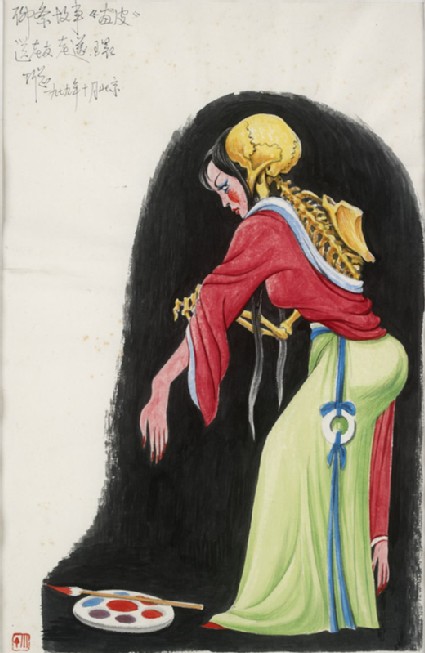Search Results: objects
Show search helpPainted Skin
- loan
-
Description
This figure is a demoness who disguises herself as a pretty teenage girl by painting her flayed skin in bright colours. In the story, the scholar Mr Wang admires her beauty and lets her stay in his studio. But at night, the demoness breaks into Wang’s bedroom and eats his heart in front of his wife.
Ding Cong, also known as Xiao Ding, was a cartoonist and illustrator from Shanghai. In the 1930s and 1940s, he was famous for his paintings about freedom and democracy, subjects to which he was able to return only in 1979. It is likely this painting is a satirical reference to Mao Zedong’s wife Jiang Qing as the artist Ding Cong had suffered so much during the Cultural Revolution (1966-1976).
-
Details
- Associated place
-
Asia › China › Hebei province › Beijing (place of creation)
- Date
- October 1979
- Associated people
-
Khoan Sullivan (1919 - 2003) (recipient)Michael Sullivan (1916 - 2013) (recipient)
- Material and technique
- ink and colour on paper
- Dimensions
-
frame 43.3 x 36 x 3.8 cm (height x width x depth)
painting 29.8 x 20.3 cm (height x width)
- Material index
- Technique index
- Object type index
- No. of items
- 1
- Credit line
- On loan from the Khoan and Michael Sullivan Collection.
- Accession no.
- LI1109.9
-
Further reading
Sullivan, Michael, Modern Chinese Art: The Khoan and Michael Sullivan Collection, revised edn (Oxford: Ashmolean Museum, 2009), no. 97 on p. 288, illus. p. 288 fig. 97
Glossary
Ding
-
Ding
A Chinese bronze tripod ritual cooking vessel. Also a type of white porcelain from Northern China.
Past Exhibition
see (1)Location
-
- currently in research collection
Objects are sometimes moved to a different location. Our object location data is usually updated on a monthly basis. Contact the Jameel Study Centre if you are planning to visit the museum to see a particular object on display, or would like to arrange an appointment to see an object in our reserve collections.
© 2013 University of Oxford - Ashmolean Museum


